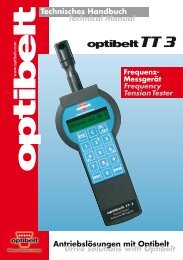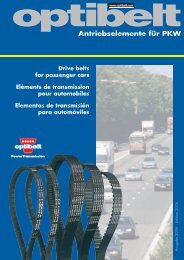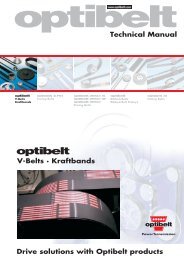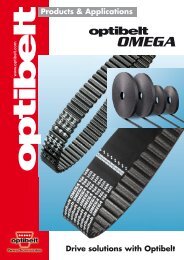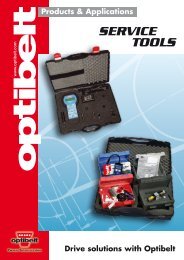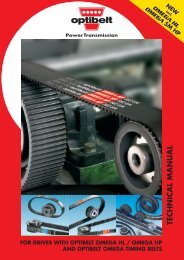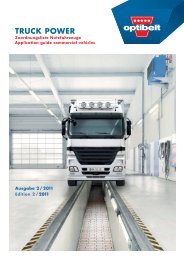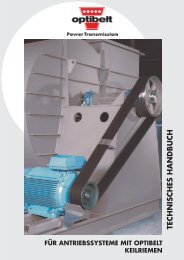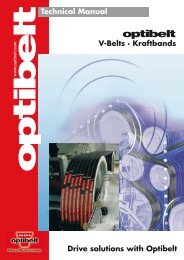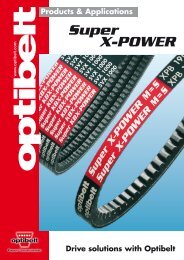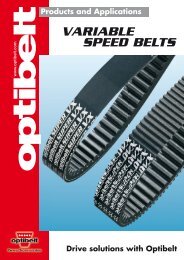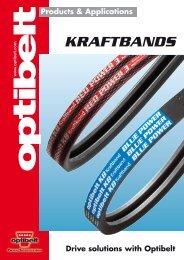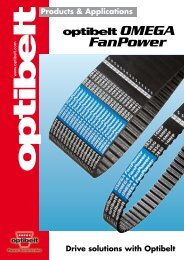The V-belt comes to Höxter - Blažek Power Transmission
The V-belt comes to Höxter - Blažek Power Transmission
The V-belt comes to Höxter - Blažek Power Transmission
You also want an ePaper? Increase the reach of your titles
YUMPU automatically turns print PDFs into web optimized ePapers that Google loves.
T r a d i t i o n<br />
a n d H i s t o r y > > >
1<br />
M DCCCLXXII<br />
<strong>The</strong> His<strong>to</strong>ry of the Arntz Opti<strong>belt</strong> Group<br />
<strong>The</strong> addition of Roman numerals surely<br />
is not a part of “higher mathematics”.<br />
<strong>The</strong> date, however, resulting from our little calculation<br />
is of highest importance for our company’s his<strong>to</strong>ry:<br />
It marks the date when Emil Arntz<br />
set up the “<strong>Höxter</strong>sche Gummifädenfabrik“<br />
(rubber thread fac<strong>to</strong>ry, <strong>Höxter</strong>).<br />
1872<br />
It was the year
<strong>The</strong> his<strong>to</strong>ry<br />
of the Arntz Opti<strong>belt</strong> Group<br />
Preface<br />
In 2007, the Arntz Opti<strong>belt</strong> Group could look back at 135 years<br />
of existence. Since its foundation in 1872, the development of the<br />
group was characterised by continuous innovations in rubber and<br />
drive technology – for the benefit of the worldwide cus<strong>to</strong>mer base<br />
and for the benefit of the company’s progress. During the year-long<br />
development, the name Opti<strong>belt</strong> has become an established brand,<br />
renowned for high quality and innovative drive solutions far<br />
beyond professional circles.<br />
A s one of the leading manufacturers and suppliers of drive <strong>belt</strong>s<br />
and other rubber based or synthetical products, the main goal<br />
of the Arntz Opti<strong>belt</strong> Group and its employees has always been the<br />
continuous optimisation of production processes and applications.<br />
Thus, Opti<strong>belt</strong> has established drive <strong>belt</strong>s as a powerful and cost-<br />
effective alternative <strong>to</strong> mechanical drives and chain drives for premium<br />
technical devices. Today, it is unimaginable <strong>to</strong> run technically<br />
demanding products such as harvesters, household appliances or<br />
machine <strong>to</strong>ols, let alone vehicles, without <strong>belt</strong>s for power transmission.<br />
<strong>The</strong>y tirelessly fulfil their tasks – mostly hidden behind covers<br />
and mounting <strong>to</strong>ps – often exceeding the operational life of the<br />
machines.<br />
<strong>The</strong> His<strong>to</strong>ry of the Arntz Opti<strong>belt</strong> Group 2
3<br />
<strong>The</strong> beginnings<br />
Emil Arntz<br />
Germany during the second half<br />
of the 19th century: <strong>The</strong> industrialisation<br />
is reaching its climax.<br />
Inventions like electric lighting,<br />
X-ray and the typewriter are<br />
changing the face of the working<br />
world. <strong>The</strong> first cars appear<br />
on the streets. <strong>The</strong> use of the<br />
steam engine improves and<br />
boosts the textile industry as<br />
never expected. Raw materials<br />
and produced goods are<br />
quickly and cost-effectively<br />
transported by railway.<br />
<strong>The</strong> German Emperor Wilhelm I<br />
reigns the empire, however,<br />
only as a representative, as the<br />
country is actually ruled by<br />
someone else: Ot<strong>to</strong> von Bismarck<br />
has the state business<br />
firmly under his control.<br />
<strong>The</strong> emperor often gives in <strong>to</strong><br />
Bismarck’s decisions stating:<br />
“It is not easy <strong>to</strong> be emperor<br />
under Bismarck.“<br />
<strong>The</strong> His<strong>to</strong>ry of the Arntz Opti<strong>belt</strong> Group<br />
During this period of industrial<br />
and economic advancement,<br />
one man in the little Westphalian<br />
country <strong>to</strong>wn of <strong>Höxter</strong> rises<br />
up. Emil Arntz, a domain tenant<br />
in Corvey, has earned a pretty<br />
penny by providing the Prussian<br />
army with grain. In his former<br />
home<strong>to</strong>wn of Wuppertal he has<br />
already scrutinised the developments<br />
for quite a while. In this<br />
<strong>to</strong>wn, the soaring progress from<br />
trade <strong>to</strong> industrial production is<br />
more than obvious. In Wuppertal,<br />
he also learns about the<br />
production of braids and rubber<br />
bands, and is soon convinced<br />
that rubber threads imported<br />
from England will make a valuable<br />
business. He gets in <strong>to</strong>uch<br />
with a British expert and in<br />
1872 starts the production of<br />
rubber threads with ten workers.
Iron-rolling mill in 1875<br />
Working conditions at the beginning of the Industrial Age in Germany<br />
<strong>The</strong> illustration gives a vivid insight in the atmosphere of an industrial business<br />
in the 19th century.<br />
It was made around 1875 by the German painter and illustra<strong>to</strong>r Adolph von Menzel.<br />
It is called “<strong>The</strong> Iron-Rolling Mill” and is exhibited in the National Gallery in Berlin.<br />
Three years previously, in 1872, Emil Arntz founded the “<strong>Höxter</strong>sche Gummifädenfabrik“.<br />
<strong>The</strong> His<strong>to</strong>ry of the Arntz Opti<strong>belt</strong> Group 4
5<br />
Even back then:<br />
cus<strong>to</strong>mers are convinced by the high quality level<br />
of Opti<strong>belt</strong> products<br />
Emil Arntz does not set up his<br />
new business in the industrial<br />
centres of the Ruhr Area but in<br />
<strong>Höxter</strong> at the Weser. As his<strong>to</strong>rical<br />
pho<strong>to</strong>graphs show, the<br />
“<strong>Höxter</strong>sche Gummifädenfabrik“<br />
already had a huge production<br />
hall at the turn of the<br />
century with a flat gable roof<br />
and big windows.<br />
<strong>The</strong> first <strong>to</strong> purchase rubber<br />
threads from <strong>Höxter</strong> are the<br />
textile fac<strong>to</strong>ries in Wuppertal.<br />
<strong>The</strong> business idea is a great<br />
success.<br />
During the next years, the entrepreneurial<br />
businessman extends<br />
the production range with<br />
moulded articles such as brake<br />
pads for carriages, treadles for<br />
bicycles, door mats, football<br />
bladders, ice bags, hot water<br />
bottles, rubber suction plates for<br />
dentures as well as air and<br />
water cushions which offer bedfast<br />
patients pain relief.<br />
Furthermore, Arntz produces<br />
rubberised fabrics for the production<br />
of aprons, miner overalls,<br />
and bed padding. Since<br />
1880, a new product supplements<br />
the product range: dental<br />
rubber used for dentures. This<br />
product, which is still sold until<br />
1955, finds a ready market all<br />
around Europe.<br />
<strong>The</strong> His<strong>to</strong>ry of the Arntz Opti<strong>belt</strong> Group<br />
This letterhead dates back <strong>to</strong> the years before 1909.<br />
When rummaging in the archive,<br />
one can find handwritten<br />
letters of the company’s founder.<br />
<strong>The</strong>y reveal that even back then,<br />
the cus<strong>to</strong>mers were convinced<br />
by the high quality of the products.<br />
And the <strong>belt</strong>s are supplied<br />
<strong>to</strong> foreign cities which are still<br />
among the most important sales<br />
areas <strong>to</strong>day: Antwerp, Copenhagen,<br />
Zurich, London, Bucharest,<br />
Vienna and many more.<br />
Despite the expanding order volume,<br />
the company has <strong>to</strong> deal<br />
with many difficulties. <strong>The</strong> huge<br />
price fluctuations of the raw material<br />
natural rubber (from 5 <strong>to</strong><br />
20 DM per kilogramme) hamper<br />
the calculation. Furthermore,<br />
competi<strong>to</strong>rs from England are<br />
still causing the upcoming company<br />
a lot of trouble.<br />
*<br />
If the anecdotes <strong>to</strong>ld are true,<br />
Emil Arntz also enjoys many<br />
happy moments besides work:<br />
He likes <strong>to</strong> take a walk <strong>to</strong> <strong>Höxter</strong><br />
with the former librarian of<br />
the baronial library of Corvey,<br />
August Hoffmann von Fallersleben,<br />
<strong>to</strong> enjoy a bottle of wine<br />
in the then tavern “Club”.<br />
On February 19th, 1909 Emil<br />
Arntz dies after a long and<br />
severe illness.
Modernisation and expansion of the fac<strong>to</strong>ry ...<br />
new boiler and machine house<br />
Richard Arntz<br />
Emil’s son Richard takes over the management<br />
After the death of Emil Arntz his<br />
son Richard (1866-1934) assumes<br />
the position of managing<br />
direc<strong>to</strong>r. Until then, he has<br />
mainly been responsible for<br />
sales, and has constantly extended<br />
the cus<strong>to</strong>mer base. Thus,<br />
the young man has visited almost<br />
every country of the world.<br />
Richard Arntz dynamically starts<br />
the modernisation and expansion<br />
of the fac<strong>to</strong>ry. Between<br />
1910 and 1912, a four-s<strong>to</strong>rey<br />
building is constructed on the<br />
premises between the Corveyer<br />
Allee and the Bismarckstraße in<br />
<strong>Höxter</strong>. Only one year later, the<br />
direc<strong>to</strong>r initiates the construction<br />
of a new boiler and machine<br />
house. It is equipped with an<br />
innovative steam engine plant<br />
which is not replaced by a<br />
new, modern plant until<br />
the 1960s<br />
One of Richard Arntz’ main<br />
achievements is the co-operation<br />
with an American expert who<br />
designs new machines which<br />
guarantee an optimised cutting<br />
process. Thus the “<strong>Höxter</strong>sche<br />
Gummifädenfabrik“ has a technological<br />
advance and competitive<br />
edge for decades.<br />
<strong>The</strong> His<strong>to</strong>ry of the Arntz Opti<strong>belt</strong> Group 6
7<br />
<strong>The</strong> government confiscates<br />
the whole s<strong>to</strong>ck of raw rubber …<br />
<strong>The</strong> consequences of the First World War<br />
<strong>The</strong> outbreak of the First World<br />
War in 1914 puts an end <strong>to</strong> the<br />
promising development of the<br />
“<strong>Höxter</strong>sche Gummifädenfabrik“<br />
as the government confiscates<br />
the whole s<strong>to</strong>ck of raw<br />
rubber without further ado. <strong>The</strong><br />
fac<strong>to</strong>ry in the country <strong>to</strong>wn at<br />
the Weser has <strong>to</strong> finish production,<br />
and is shut down.<br />
<strong>The</strong> His<strong>to</strong>ry of the Arntz Opti<strong>belt</strong> Group<br />
After the war in 1918, the<br />
“<strong>Höxter</strong>sche Gummifäden fabrik“<br />
can only slowly resume production.<br />
It is not until 1920 that<br />
Richard Arntz and his brother<br />
Oskar begin <strong>to</strong> manufacture<br />
dental rubber for dentures,<br />
brand “Elefant“ (elephant).<br />
One year later, the production<br />
of rubber threads, rubberised<br />
fabrics and rubber mats is taken<br />
up again.<br />
During the 1920s, <strong>to</strong>day often<br />
willingly glorified as the<br />
“Golden” or “Roaring Twenties“,<br />
Germany is increasingly pressurised.<br />
Reparations, the crisis in<br />
the Ruhr Area, inflation and<br />
political uprisings determine the<br />
economic and social climate;<br />
economy is almost brought <strong>to</strong> a<br />
standstill. <strong>The</strong> business dealings<br />
of the fac<strong>to</strong>ry in <strong>Höxter</strong> are<br />
poor. It is not until the middle<br />
of the 1920s that the positive<br />
upward trend of the company is<br />
continued. Sixty male and thirty<br />
female workers are employed in<br />
the fac<strong>to</strong>ry in the Corveyer<br />
Allee.<br />
Furthermore, a new man joins<br />
the company: Paul Kuhlo, one<br />
of Emil Arntz‘ grandsons and<br />
a banker from Berlin, now<br />
strengthens the management<br />
board.
Paul Kuhlo<br />
<strong>The</strong> global economic crisis<br />
leaves many people<br />
in misery and poverty<br />
<strong>The</strong> global economic crisis<br />
<strong>The</strong> s<strong>to</strong>ck market crash in New<br />
York in 1929 puts an end <strong>to</strong> all<br />
positive trends. <strong>The</strong> global economic<br />
crisis leaves a lot of people<br />
in misery and poverty. <strong>The</strong><br />
economic collapse leads <strong>to</strong> the<br />
shutdown of many, even major<br />
rubber production facilities or <strong>to</strong><br />
the acquisition by the “Continental-Gummiwerke”<br />
in Hannover.<br />
<strong>The</strong> “<strong>Höxter</strong>sche Gummifädenfabrik“<br />
is deeply affected by the<br />
decline of business. However,<br />
due <strong>to</strong> the premium/better quality<br />
of the rubber threads and<br />
by means of the careful and<br />
thoughtful management, the<br />
company can leave the competition<br />
behind. <strong>The</strong> head of the<br />
company Richard Arntz is in<br />
poor health.<br />
<strong>The</strong> years of setup and recession<br />
have left their mark on his<br />
health. After a stroke at the age<br />
of 63, the businessman cannot<br />
recover completely. <strong>The</strong>refore,<br />
in 1929, the Arntz family confers<br />
the management of the<br />
company on Paul Kuhlo.<br />
Richard Arntz dies in April<br />
1934. His wife, Ida Arntz, remains<br />
loyal <strong>to</strong> her husband’s<br />
lifework for decades, and plays<br />
a vital role in the continuous<br />
growth of the business until her<br />
own death in 1966.<br />
In <strong>Höxter</strong>, a street is named after<br />
the successful businessman.<br />
<strong>The</strong> His<strong>to</strong>ry of the Arntz Opti<strong>belt</strong> Group 8
9<br />
Instruction for the handling of rubber threads<br />
Technological developments<br />
During the 1920s the rubber-industry<br />
is exposed <strong>to</strong> revolutionary<br />
discoveries, new techno logi -<br />
cal developments and economic<br />
changes. One of the main experimental<br />
areas is concerned<br />
with research projects dealing<br />
with the production of artificial<br />
rubber. Already in 1927 first<br />
attempts at the development of<br />
<strong>The</strong> His<strong>to</strong>ry of the Arntz Opti<strong>belt</strong> Group<br />
vulcanisation activa<strong>to</strong>rs and<br />
aging preservatives have been<br />
made. This leads <strong>to</strong> an essential<br />
cutting of vulcanisation times.<br />
<strong>The</strong> quality of the rubber threads<br />
and other rubber-based products<br />
is improved significantly. <strong>The</strong><br />
company Bayer in Leverkusen<br />
elaborates a synthesis method<br />
already developed in 1915.<br />
A new product type hits the<br />
market. It is named after the<br />
abbreviation of its two components,<br />
butadiene and sodium<br />
(in German called “Natrium”):<br />
Buna, the world-famous brand<br />
for synthetical rubber ever since.
New production process<br />
opens up new markets<br />
<strong>The</strong> “International Rubber Thread Association“<br />
After the great depression, the<br />
use of rubber threads has massively<br />
declined. Competition between<br />
the remaining production<br />
facilities is becoming more and<br />
more of a rat race. Many foreign<br />
businesses, especially<br />
those from America and Japan,<br />
are able <strong>to</strong> systematically undercut<br />
the prices on the rubber<br />
thread market due <strong>to</strong> the devaluation<br />
of their home currency.<br />
Thus, they can easily dominate<br />
the market and gain most of the<br />
revenues. In 1930, the sales in<br />
Germany are so low that all<br />
rubber thread fac<strong>to</strong>ries suffer<br />
from losses of about one million<br />
Reichsmark. Many fac<strong>to</strong>ries<br />
have <strong>to</strong> struggle hard.<br />
Rubber threads<br />
in square design, brand “Optifil”<br />
Thickness: 0.42-4.2 mm<br />
Colours: Blue-white and brown<br />
in round design, brand “Circofil”<br />
Thickness: 0.47-0.91 mm<br />
Colours: Dark gray, blue-white and pure white<br />
<strong>The</strong> threads are coiled on rental spools which<br />
have <strong>to</strong> be sent back franco after taking off the<br />
threads.<br />
Under the mot<strong>to</strong> “Only <strong>to</strong>gether<br />
we are strong“, the “International<br />
Rubber Thread Association“<br />
(IRTA) is founded: its<br />
intention is <strong>to</strong> bring about international<br />
understanding and cooperation<br />
between European<br />
fac<strong>to</strong>ries and the most important<br />
American companies. It aims at<br />
providing a wholesome market<br />
control – for the benefit of the<br />
manufacturers as well as of the<br />
end users. <strong>The</strong> “<strong>Höxter</strong>sche<br />
Gummifädenfabrik“ plays a decisive<br />
role in the founding of the<br />
association. Until the outbreak<br />
of World War II, the company<br />
has major influence in the organisation.<br />
With the association’s help, the<br />
import of foreign rubber threads<br />
is kept at bay. <strong>The</strong> former market<br />
is almost completely regained.<br />
Para boards<br />
with fine bilateral fabric impression<br />
Thickness: 0.32-4.2 mm<br />
with an acceptable <strong>to</strong>lerance of ± 5 %<br />
Colours: Brown, blue-white and red<br />
Board width: 110-128 cm<br />
Fine rubber threads<br />
A new production process<br />
brings along further new cus<strong>to</strong>mers<br />
for the fac<strong>to</strong>ry in <strong>Höxter</strong>.<br />
In June 1937, the experimental<br />
production of extruded round<br />
latex threads is started. After<br />
the construction of a suitable<br />
facility, the “<strong>Höxter</strong>sche Gummifädenfabrik“<br />
can finally provide<br />
the corsetry and hosiery industry<br />
with the demanded fine<br />
rubber threads up <strong>to</strong> a diameter<br />
of 0.2 mm.<br />
Para strips<br />
with fine bilateral fabric impression,<br />
cut in the desired width from the boards mentioned<br />
above<br />
Production length: 35-130 m<br />
with a smooth surface<br />
Thickness: 0.32-4.2 mm with a <strong>to</strong>lerance<br />
of ± 5 %<br />
Width: 20-40 mm<br />
Colours: Brown and blue-white<br />
Special design<br />
Brand “Novofil – P”<br />
conditionally oil and petrol resistant<br />
<strong>The</strong> His<strong>to</strong>ry of the Arntz Opti<strong>belt</strong> Group 10
11<br />
Under the regime of the<br />
National Socialists<br />
<strong>The</strong> His<strong>to</strong>ry of the Arntz Opti<strong>belt</strong> Group<br />
Political situation<br />
in Germany<br />
dramatically changes<br />
At the beginning of the 1930s,<br />
the political situation in Germany<br />
dramatically changes:<br />
Adolf Hitler assumes power and<br />
realises his malign plans. <strong>The</strong><br />
preparations for war are in full<br />
swing. Due <strong>to</strong> autarchy attempts<br />
of the National Socialists, the<br />
fac<strong>to</strong>ries are forced <strong>to</strong> replace<br />
cot<strong>to</strong>n by cellular wool. <strong>The</strong><br />
quality and tensile strength of<br />
the rubber end products leaves<br />
a lot <strong>to</strong> be desired. <strong>The</strong> experts<br />
in <strong>Höxter</strong> therefore decide <strong>to</strong> set<br />
up a chemical labora<strong>to</strong>ry for the<br />
thorough analysis of the new<br />
basic materials. Despite the devastating<br />
news from politics and<br />
the anti-German sentiment in<br />
other countries, the “<strong>Höxter</strong>sche<br />
Gummifädenfabrik“ succeeds in<br />
standing its ground in the market.<br />
<strong>The</strong> production facilities are<br />
continuously expanded and<br />
modernised. At times, 20 <strong>to</strong>ns<br />
of rubber threads leave the fac<strong>to</strong>ry<br />
per month. At the beginning<br />
of the war, the staff consists<br />
of twelve employees as well as<br />
135 male and female workers.<br />
<strong>The</strong> Second World War<br />
However, war brings about a<br />
great retracement: A lot of materials<br />
and goods are no longer<br />
available, or only after time consuming<br />
approval processes. Al-<br />
<strong>The</strong> Second World War in Europe and North Africa<br />
ready after the first year of war,<br />
the shortage of raw rubber forces<br />
fac<strong>to</strong>ries <strong>to</strong> blend the mixture<br />
with 25 percent of Buna. At the<br />
end of World War II, the mixing<br />
ratio is 75 percent of Buna and<br />
only 25 percent of natural rubber.<br />
<strong>The</strong> quality is enormously<br />
reduced as the new type of<br />
material is not easy <strong>to</strong> handle.<br />
Numerous experiments and the<br />
intensive exchange of experiences<br />
between the German<br />
manufacturers of rubber threads<br />
are successful: good and nonageing<br />
threads made of 100 percent<br />
Buna – i.e. completely<br />
without natural rubber – can<br />
finally be produced.<br />
With the military draft <strong>to</strong> the<br />
Wehr macht, the staff of the<br />
“<strong>Höxter</strong>sche Gummifädenfabrik“<br />
is reduced significantly. In April<br />
1945 only 65 employees are<br />
still working in the “<strong>Höxter</strong>sche<br />
Gummifädenfabrik“.
Price list from the 1950s<br />
<strong>The</strong> His<strong>to</strong>ry of the Arntz Opti<strong>belt</strong> Group 12
13<br />
At the end of the war, the fac<strong>to</strong>ry<br />
in the Corveyer Allee luckily<br />
escapes sabotage and<br />
depredations. Shortly before the<br />
occupation of the American<br />
troops in <strong>Höxter</strong> only a few grenades<br />
have caused minor damage<br />
<strong>to</strong> buildings which can all<br />
easily be repaired quickly during<br />
the summer of 1945.<br />
<strong>The</strong> His<strong>to</strong>ry of the Arntz Opti<strong>belt</strong> Group<br />
<strong>The</strong> company’s “treasure”:<br />
a company-owned woodgas<br />
powered Büssing lorry<br />
<strong>The</strong> economic restart after 1945<br />
<strong>The</strong> company is lucky during<br />
those hard times: <strong>The</strong> American<br />
military government grants the<br />
“<strong>Höxter</strong>sche Gummifädenfabrik“<br />
the license <strong>to</strong> recommence production<br />
– as one of the first companies<br />
in the rubber-producing<br />
sec<strong>to</strong>r. However, the purchase of<br />
materials is still quite difficult.<br />
Most suppliers of raw materials<br />
have not taken up production<br />
yet; the infrastructure is destroyed,<br />
or barred by zonal borders.<br />
If someone back then wanted <strong>to</strong><br />
travel from <strong>Höxter</strong> <strong>to</strong> Lippstadt 1 ,<br />
for example, he had <strong>to</strong> leave the<br />
train at Altenbeken 2 because the<br />
viaduct was destroyed. From<br />
there, he either had <strong>to</strong> walk all<br />
the way <strong>to</strong> Neuenbeken 3 or<br />
travel by horse-cart. At Neuenbeken<br />
a connecting train left for<br />
Paderborn 4 . Thus, a journey by<br />
train often <strong>to</strong>ok a whole day.<br />
Back then, the “treasure” of the<br />
fac<strong>to</strong>ry is a company-owned<br />
woodgas powered Büssing<br />
lorry. It is on the road tirelessly,<br />
Annotations:<br />
1 <strong>Höxter</strong>–Lippstadt: 90 km; <strong>Höxter</strong>–Altenbeken: 40 km<br />
2 Altenbeken–Neuenbeken: 7 km<br />
3 Neuenbeken–Paderborn: 8 km<br />
4 Paderborn–Lippstadt: 35 km<br />
and thus saves the company<br />
from production downtime many<br />
times – especially, when it<br />
<strong>comes</strong> back late at night from<br />
the Ruhr Area, loaded with coal<br />
<strong>to</strong> fill up the empty bunkers.<br />
Both drivers work all day and<br />
night, often until they are <strong>to</strong>tally<br />
exhausted and burned out, in<br />
order <strong>to</strong> keep up the production<br />
in <strong>Höxter</strong>.<br />
<strong>The</strong> company-related permissions<br />
and approvals needed<br />
from the authorities of the military<br />
government are quite time<br />
consuming as well. <strong>The</strong> economic<br />
future of the fac<strong>to</strong>ry in<br />
<strong>Höxter</strong> is more than insecure: the<br />
demand for rubber threads and<br />
dental rubber is extremely low.<br />
Thus, the management board<br />
has <strong>to</strong> consider the production<br />
of additional items; otherwise<br />
the company might not survive.
Wedge <strong>belt</strong> Wire cord V-<strong>belt</strong><br />
<strong>The</strong> V-<strong>belt</strong><br />
<strong>comes</strong><br />
<strong>to</strong> <strong>Höxter</strong><br />
<strong>The</strong>re is a light at the end of the<br />
tunnel for the company in <strong>Höxter</strong>,<br />
and it is offered by a new<br />
product, the V-<strong>belt</strong>:<br />
After the war, Sudeten Germans<br />
from Odrau came <strong>to</strong> <strong>Höxter</strong>,<br />
who had already gained experience<br />
in this particular field.<br />
<strong>The</strong>y had previously been working<br />
in the rubber cable and textile<br />
company “Optimit”.<br />
Five renowned German rubber<br />
thread fac<strong>to</strong>ries had a holding<br />
in the Czech fac<strong>to</strong>ry in Moravia.<br />
One of them was the “<strong>Höxter</strong>sche<br />
Gummifädenfabrik“.<br />
Besides rubber threads and various<br />
other rubber items, this fac<strong>to</strong>ry<br />
produced V-<strong>belt</strong>s. After the<br />
expulsion of Germans from the<br />
Sudeten German terri<strong>to</strong>ries,<br />
former “Optimit” employees<br />
found a new home in Eastern<br />
Westphalia.<br />
<strong>The</strong> “<strong>Höxter</strong>sche Gummifädenfabrik“<br />
is finally convinced that<br />
the production of V-<strong>belt</strong>s can<br />
offer a secure economic base<br />
for the future. On May 19th,<br />
1947 the management board<br />
makes an application for the<br />
permission of production. However<br />
it takes almost one year,<br />
until the Economical Minister of<br />
the recently founded Federal<br />
State North Rhine-Westphalia<br />
agrees. In 1948, the V-<strong>belt</strong> production<br />
begins.<br />
<strong>The</strong> “Opti<strong>belt</strong>“, so the name of<br />
the new product, be<strong>comes</strong> a<br />
trademark in the sec<strong>to</strong>r.<br />
<strong>The</strong> His<strong>to</strong>ry of the Arntz Opti<strong>belt</strong> Group 14
15<br />
<strong>The</strong> “Opti<strong>belt</strong>”,<br />
so the name of the new product,<br />
be<strong>comes</strong> a trademark in the sec<strong>to</strong>r<br />
<strong>The</strong> His<strong>to</strong>ry of the Arntz Opti<strong>belt</strong> Group
<strong>The</strong> production of V-<strong>belt</strong>s<br />
<strong>The</strong> fac<strong>to</strong>ry at the Weser goes<br />
its own way in the production of<br />
V-<strong>belt</strong>s. It develops its own single<br />
manufacture process and<br />
designs new machines and <strong>belt</strong><br />
types. At first, three men and<br />
three women are responsible for<br />
the manufacture of the V-<strong>belt</strong>s.<br />
<strong>The</strong> wages – for the first time<br />
ever in the recently founded Federal<br />
Republic of Germany paid<br />
in deutschmark – amount <strong>to</strong><br />
eighty pfennigs per hour for<br />
male and sixty pfennigs per<br />
hour for female employees.<br />
Picture of our company in 1959<br />
<strong>The</strong> V-<strong>belt</strong> production starts<br />
under moderate technical and<br />
spatial conditions. An over fifty<br />
years old four-cylinder calendar,<br />
still driven via transmission shaft<br />
connected <strong>to</strong> a steam engine,<br />
hither<strong>to</strong> used for the pultrusion<br />
of dental rubber boards, <strong>comes</strong><br />
back in<strong>to</strong> use. Until the purchase<br />
of the new calendar in<br />
1959, it is used for the frictioning<br />
of the V-<strong>belt</strong>’s layer fabric.<br />
Brisk construction activities<br />
<strong>The</strong> production doubles from<br />
1949 <strong>to</strong> 1950 and requires bigger<br />
production facilities. Thus,<br />
the former fabric coating facility<br />
is expanded and enlarged. In<br />
1953, an annex is built in immediate<br />
vicinity, accommodating<br />
the rubber soot mixing<br />
facility and the V-<strong>belt</strong> s<strong>to</strong>rage<br />
as well as the dispatch department.<br />
In 1954, a big s<strong>to</strong>rehouse for<br />
the huge amount of materials<br />
s<strong>to</strong>red in different places is built<br />
on the former garden site.<br />
<strong>The</strong> His<strong>to</strong>ry of the Arntz Opti<strong>belt</strong> Group 16
17<br />
<strong>The</strong>re is already a new substation<br />
for the ever-growing energy<br />
demand. One year later, the V<strong>belt</strong><br />
s<strong>to</strong>ck and dispatch department<br />
get a new building which<br />
is later used as the main fac<strong>to</strong>ry<br />
building. <strong>The</strong> brisk construction<br />
activities continue in the following<br />
years as offices and employee<br />
facilities are needed.<br />
Lead by technology<br />
<strong>The</strong> system of single manufacture<br />
of V-<strong>belt</strong>s is constantly optimised<br />
during the following<br />
years. Working processes can<br />
now be au<strong>to</strong>mated. <strong>The</strong> rapid<br />
development is without precedent<br />
in the cus<strong>to</strong>mary V-<strong>belt</strong><br />
technology and is of great benefit<br />
<strong>to</strong> the “<strong>Höxter</strong>sche Gummifädenfabrik“<br />
as the machines<br />
allow for a greater flexibility in<br />
the adjustment <strong>to</strong> the ordered<br />
V-<strong>belt</strong> sections and lengths.<br />
<strong>The</strong> His<strong>to</strong>ry of the Arntz Opti<strong>belt</strong> Group<br />
In the meantime, the V-<strong>belt</strong> has<br />
been well-established in technical<br />
trade. Promising contacts with<br />
original equipment manufacturers<br />
from industry and agriculture<br />
have been made and – what is<br />
more – contacts <strong>to</strong> ambitious car<br />
companies, like VW and Ford,<br />
are made.<br />
Local relevance<br />
<strong>The</strong> V-<strong>belt</strong> production does not<br />
only help the “<strong>Höxter</strong>sche Gummifädenfabrik“<br />
<strong>to</strong> become a valuable<br />
partner in its own sec<strong>to</strong>r,<br />
the company also gains in importance<br />
for the business in the<br />
region. <strong>The</strong> patch for employees<br />
is constantly extended. While<br />
the staff amounted <strong>to</strong> 118 employees<br />
in 1947, it has risen <strong>to</strong><br />
Here some data <strong>to</strong> document this great success:<br />
189 in 1951, 255 in 1953 and<br />
485 employees in 1957.<br />
<strong>The</strong> gentlemen of the management<br />
board willingly provide<br />
their energy for many public<br />
and charitable objectives. <strong>The</strong>se<br />
special accomplishments are<br />
officially recognised with the<br />
award of the Federal Cross of<br />
Merit, first class, in 1958, when<br />
Paul Kuhlo retires due <strong>to</strong> old<br />
age.<br />
In just a short period of time,<br />
the company in <strong>Höxter</strong> be<strong>comes</strong><br />
one of the leading<br />
V-<strong>belt</strong> manufacturers<br />
in Germany<br />
From 1951 <strong>to</strong> 1954 the production quantity is<br />
almost tripled:<br />
in 1951 117 t pass through the fac<strong>to</strong>ry gates,<br />
in 1952 already 158 t,<br />
in 1953 233 t and<br />
in 1954 326 t are produced and sold.
Arnulf Ummen<br />
Production processes<br />
and working routine<br />
are optimised<br />
Arnulf Ummen takes over the helm<br />
On January 1st, 1959 the<br />
founder’s great grandson, graduate<br />
businessman Arnulf Ummen,<br />
takes over the management of<br />
the company as personally liable<br />
partner. Ummen makes things<br />
hum again and is determined <strong>to</strong><br />
expand the fac<strong>to</strong>ry. He makes<br />
substantial investments <strong>to</strong> introduce<br />
new technologies.<br />
New buildings for the manufacture<br />
of the rubber compounds<br />
are erected, equipped with<br />
modern machines. A new boiler<br />
and machine house with an up<strong>to</strong>-date<br />
steam boiler and power<br />
distribution plant provide the increasing<br />
energy demand. <strong>The</strong><br />
production processes and work<br />
routine are optimised, boosting<br />
the production quantity.<br />
Arnulf Ummen knows that the<br />
pre-conditions for a production<br />
operating at full capacity and<br />
for the fast sale of the goods is<br />
a determined sales and distribution<br />
department with own sales<br />
agencies. Technical products for<br />
the industrial sec<strong>to</strong>r can be<br />
brought <strong>to</strong> the market much better<br />
if the manufacturer does not<br />
only supply the goods but can<br />
offer an own field service. In<br />
only a short period of time,<br />
sales companies with s<strong>to</strong>rage<br />
capacities are opened in almost<br />
every major German <strong>to</strong>wn. In<br />
1962, Arnulf Ummen sets up<br />
the first internationally operating<br />
sales company in Zurich, Switzerland.<br />
Further sales companies<br />
follow in almost every<br />
Western European country as<br />
well as in Canada and the<br />
United States. Today, there are<br />
further subsidiaries in Eastern<br />
Europe, Asia and even in Australia.<br />
<strong>The</strong> years of the German economic<br />
miracle also have a<br />
major impact on <strong>Höxter</strong> and<br />
bring wealth and prosperity: in<br />
1960 803 people are employed<br />
in the fac<strong>to</strong>ry in <strong>Höxter</strong>.<br />
For the employees’ needs, the<br />
sanitary facilities are enlarged.<br />
*<br />
<strong>The</strong> His<strong>to</strong>ry of the Arntz Opti<strong>belt</strong> Group 18
19<br />
l l l set the course<br />
l l l In 1948 we started with the production of V-<strong>belt</strong>s. Due <strong>to</strong> the hard<br />
work of many a man involved we succeeded in increasing the inland<br />
revenues up <strong>to</strong> 11.6 mill. DM until 1960. In 1959, I <strong>to</strong>ok over the<br />
position as managing direc<strong>to</strong>r, and our first definite target for the<br />
expansion of the company was <strong>to</strong> achieve a production quantity of<br />
200 <strong>to</strong>ns per month and revenues of about 20 mill. DM. In 1959 and<br />
1960, when we started <strong>to</strong> work for the realisation of our plan, many<br />
people laughed at us; but let me tell you <strong>to</strong>day: We did achieve our<br />
target! l l l<br />
l l l Besides the German market we provide many foreign markets, especially<br />
those closest <strong>to</strong> us in Europe. You know my basic attitude:<br />
I consider the European market far more important than the German,<br />
especially in the long run, as the exclusive provision of the<br />
German market will never suffice for a company that wants <strong>to</strong> stand<br />
its ground in the European market. During the last couple of years,<br />
we deliberately pushed our exports and now fortunately find that<br />
we have gained an average increase of 15.7 % in exports per year,<br />
compared <strong>to</strong> an annual increase of only 4.6 % of our German competi<strong>to</strong>rs.<br />
l l l<br />
l l l <strong>The</strong> V-<strong>belt</strong>s we sell <strong>to</strong>day can hardly be compared <strong>to</strong> those back in<br />
1960. We have a much greater variety ranging from premium quality<br />
V-<strong>belt</strong>s over many types of fan <strong>belt</strong>s, <strong>belt</strong>s for agricultural machinery<br />
etc. up <strong>to</strong> <strong>belt</strong>s for light drives in domestic economy and household<br />
applications. l l l<br />
l l l We still have <strong>to</strong> keep up and increase our efforts regarding exports,<br />
though. In 20 years time, we have <strong>to</strong> pull in 20-times as much revenue<br />
as <strong>to</strong>day, and that surely won’t be easy. l l l<br />
l l l It is my responsibility as a businessman <strong>to</strong> set the course for a development<br />
<strong>to</strong>day that will secure your and all employees’ salaries<br />
and pensions in the future. In my eyes, the only chance <strong>to</strong> achieve<br />
this is by expansion and aggressive progress, for we have no other<br />
means of securing our influence. l l l<br />
<strong>The</strong> His<strong>to</strong>ry of the Arntz Opti<strong>belt</strong> Group<br />
for the future<br />
<strong>to</strong>day l l l<br />
A r n u l f ummen · Extracts from a lecture during a sales training in 1965
Opti<strong>belt</strong> weltweit<br />
Opti<strong>belt</strong> worldwide<br />
Kanada<br />
USA<br />
Brasilien<br />
International orientation<br />
gives the cutting edge<br />
Afrika<br />
Europa<br />
Opti<strong>belt</strong> – represented in all markets around the world<br />
Dynamic development<br />
Indien<br />
<strong>The</strong> demand for V-<strong>belt</strong>s is increasing<br />
substantially during the<br />
1960s. <strong>The</strong> product range is<br />
continuously extended and cus<strong>to</strong>mised<br />
<strong>to</strong> the new markets.<br />
Arnulf Ummen is increasingly<br />
responsible for the rapid expansion<br />
of the company: at the end<br />
of 1967, the “<strong>Höxter</strong>sche<br />
Gummifädenfabrik“ purchases<br />
the “Roderwald-Antrieb AG” in<br />
Berlin, for which new and bigger<br />
production facilities are built<br />
in Berlin-Marienfelde. From<br />
there, all Eastern European states<br />
are supplied.<br />
China<br />
Singapur<br />
Australien<br />
www.opti<strong>belt</strong>.com<br />
Opti<strong>belt</strong> GmbH<br />
D-37671 <strong>Höxter</strong><br />
www.opti<strong>belt</strong>.de<br />
Opti<strong>belt</strong> (UK) Ltd.<br />
GB-Warring<strong>to</strong>n WA2 8QY<br />
www.opti<strong>belt</strong>.co.uk<br />
Opti<strong>belt</strong> Nederland B.V.<br />
NL-2181 HC Hillegom<br />
www.opti<strong>belt</strong>.nl<br />
Opti<strong>belt</strong> Finland Oy<br />
FI-00750 Helsinki<br />
www.opti<strong>belt</strong>.fi<br />
Opti<strong>belt</strong> Skandinaviska AB<br />
S-21762 Malmö<br />
www.opti<strong>belt</strong>.se<br />
Verkauf Dänemark<br />
Sales Denmark<br />
www.opti<strong>belt</strong>.dk<br />
Verkauf Norwegen<br />
Sales Norway<br />
www.opti<strong>belt</strong>.no<br />
Opti<strong>belt</strong> France SAS<br />
F-68520 Burnhaupt-le-Haut<br />
www.opti<strong>belt</strong>.fr<br />
Opti<strong>belt</strong> AG<br />
CH-4657 Dulliken<br />
www.opti<strong>belt</strong>.ch<br />
Opti<strong>belt</strong> GmbH<br />
B-2160 Wommelgem<br />
www.opti<strong>belt</strong>.be<br />
Opti<strong>belt</strong> España, S.A.<br />
E-08205 Sabadell<br />
www.opti<strong>belt</strong>.es<br />
Opti<strong>belt</strong> AG<br />
I-20025 Legnano (Mi)<br />
www.opti<strong>belt</strong>.it<br />
Opti<strong>belt</strong> Österreich GmbH<br />
A-1230 Wien<br />
www.opti<strong>belt</strong>.at<br />
Opti<strong>belt</strong> Polska Sp. z o.o.<br />
PL-41-303 Da˛browa Górnicza<br />
www.opti<strong>belt</strong>.pl<br />
OOO „Opti<strong>belt</strong> <strong>Power</strong> <strong>Transmission</strong>”<br />
141800 Dmitrow<br />
www.opti<strong>belt</strong>.ru<br />
Opti<strong>belt</strong> Hungary Kft.<br />
H-6792 Zsombó<br />
www.opti<strong>belt</strong>.hu<br />
Opti<strong>belt</strong> Corporation<br />
Addison, Illinois 60 101/USA<br />
www.opti<strong>belt</strong>.us<br />
Opti<strong>belt</strong> (Canada) Inc.<br />
L3R 4H9 Markham, Ontario/Canada<br />
www.opti<strong>belt</strong>.ca<br />
Opti<strong>belt</strong> do Brasil Ltda.<br />
CEP 04715-002 São Paulo-SP/Brasil<br />
www.opti<strong>belt</strong>-br.com<br />
Opti<strong>belt</strong> Asia Pacific Pte. Ltd.<br />
Singapore 508708<br />
www.opti<strong>belt</strong>.sg<br />
Opti<strong>belt</strong> <strong>Power</strong> <strong>Transmission</strong><br />
(Shanghai) Co., Ltd.<br />
Shanghai 201612/P.R. China<br />
www.opti<strong>belt</strong>.cn<br />
Opti<strong>belt</strong><br />
<strong>Power</strong> <strong>Transmission</strong> India Pvt. Ltd.<br />
Vishrantwadi, Pune - 411 015<br />
www.opti<strong>belt</strong>.in<br />
Opti<strong>belt</strong> Australia PTY. LTD.<br />
Dandenong, Vic<strong>to</strong>ria 3175<br />
www.opti<strong>belt</strong>.com.au<br />
Furthermore the company is looking<br />
for an economically attractive<br />
location for the supply of EFTAcountries<br />
(European Free Trade<br />
Association, a forerunner of the<br />
EU). Northern Ireland be<strong>comes</strong><br />
the country of choice. <strong>The</strong> government<br />
of Northern Ireland is<br />
open-minded against the new establishment<br />
of industry, and even<br />
supports it.<br />
<strong>The</strong> Arntz Belting Company Ltd<br />
is founded. <strong>The</strong> company is<br />
equipped from <strong>Höxter</strong>. It starts<br />
production already in July 1968<br />
with a small workforce of experts<br />
from the parent fac<strong>to</strong>ry<br />
and some local residents trained<br />
on-site.<br />
In 1975, the “<strong>Höxter</strong>sche Gummifädenfabrik“<br />
is renamed as<br />
Arntz Opti<strong>belt</strong> KG, a name with<br />
international relevance. In the<br />
French region of Alsace, the<br />
Transac S.A. participates in the<br />
group since 1983. In the Republic<br />
of Ireland, the A + M Belting<br />
Company is added as a production<br />
facility in 1991. However,<br />
Opti<strong>belt</strong> also has <strong>to</strong> cope with<br />
setbacks. <strong>The</strong> serious overthrow<br />
in Eastern Europe induces Opti<strong>belt</strong><br />
<strong>to</strong> shut down its production<br />
site in Berlin, specialising in the<br />
supply of Eastern Europe, in<br />
1991. <strong>The</strong>se markets then have<br />
<strong>to</strong> be supplied by other production<br />
sites.<br />
In the reunified Germany a new<br />
fac<strong>to</strong>ry, the Opti<strong>belt</strong> Produktions<br />
GmbH & Co. KG, is set up in<br />
Bad Blankenburg, Thuringia, in<br />
1995. On Oc<strong>to</strong>ber 18th, 2007<br />
the Arntz Opti<strong>belt</strong> Group sets a<br />
miles<strong>to</strong>ne in its 135 years of<br />
company his<strong>to</strong>ry. On this day,<br />
the first non-European fac<strong>to</strong>ry<br />
opens near Shanghai/China.<br />
Today, the group of companies<br />
is entrenched in all important<br />
markets around the world. <strong>The</strong><br />
international orientation gains<br />
the Arntz Opti<strong>belt</strong> Group a vital<br />
edge.<br />
<strong>The</strong> His<strong>to</strong>ry of the Arntz Opti<strong>belt</strong> Group 20
21<br />
<strong>Höxter</strong>, Germany<br />
Thuringia<br />
In 2009, a new production<br />
facility is set up in Romania.<br />
In every production facility high<br />
quality drive elements are<br />
produced. However, each<br />
individual site has its own<br />
market-oriented features. <strong>The</strong><br />
leap across regional boundaries,<br />
not least, is in response <strong>to</strong><br />
the challenges posed by a stiffening<br />
of competition.<br />
<strong>The</strong> His<strong>to</strong>ry of the Arntz Opti<strong>belt</strong> Group<br />
China<br />
Romania
THE MANAGEMENT BOARD OF THE ARNTZ OPTIBELT GROUP<br />
Heinz Wilkening Konrad Ummen Dr. Arnd Mathias<br />
<strong>The</strong> His<strong>to</strong>ry of the Arntz Opti<strong>belt</strong> Group 22
23<br />
<strong>The</strong> His<strong>to</strong>ry of the Arntz Opti<strong>belt</strong> Group<br />
Founder: Emil Arntz, 1872, <strong>Höxter</strong><br />
Trademark registration Opti<strong>belt</strong>:<br />
23. 09. 1953, DPMA Munich<br />
Certificates (extract):<br />
“Top-Partner”, VTH Verband Technischer<br />
Handel (1999, 2004)<br />
“Preferred Supplier”, Claas combine<br />
harvesters (2006)<br />
COMPANY<br />
Opti<strong>belt</strong> GmbH<br />
Headquarters: <strong>Höxter</strong>, Deutschland<br />
Management Board:<br />
Heinz Wilkening, Konrad Ummen,<br />
Dr. Arnd Mathias<br />
Distribution: worldwide, with own<br />
distribution companies and distribu<strong>to</strong>rs<br />
Employees: approx. 1400 worldwide<br />
MILESTONES<br />
1872 Emil Arntz sets up the “<strong>Höxter</strong>sche<br />
Gummifädenfabrik” (rubber thread<br />
fac<strong>to</strong>ry, <strong>Höxter</strong>)<br />
1948 Start of the V-<strong>belt</strong> production; the<br />
V-<strong>belt</strong> is named “Opti<strong>belt</strong>”<br />
1960-1975 Set-up of the first Opti<strong>belt</strong><br />
distribution companies in Europe<br />
1999 Opti<strong>belt</strong> manufactures the worldwide<br />
exclusive maintenance-free wrapped<br />
V-<strong>belt</strong>, the Opti<strong>belt</strong> RED POWER<br />
2007 Set up of a production site in<br />
China<br />
2008 <strong>The</strong> Arntz Opti<strong>belt</strong> Group expands<br />
in Romania<br />
2009 Market launch of the high performance<br />
timing <strong>belt</strong> ALPHA <strong>Power</strong><br />
DATES AND FACTS<br />
Brand name: Opti<strong>belt</strong>, acronym, combination<br />
of “optimal” and “<strong>belt</strong>”<br />
Slogan: “Opti<strong>belt</strong> – Passion Meets<br />
Precision”<br />
Pho<strong>to</strong>graph of the main fac<strong>to</strong>ry and headquarters<br />
of the Arntz Opti<strong>belt</strong> Group in <strong>Höxter</strong>
Impre<br />
<strong>The</strong> His<strong>to</strong>ry of the Arntz Opti<strong>belt</strong> Group 24
ssIons<br />
25<br />
<strong>The</strong> His<strong>to</strong>ry of the Arntz Opti<strong>belt</strong> Group
Domain Brenkhausen<br />
Gipsfac<strong>to</strong>ry,<br />
Cement plant, Godelheim<br />
<strong>The</strong> His<strong>to</strong>ry of the Arntz Opti<strong>belt</strong> Group 26
Stad<strong>to</strong>ldendorf<br />
<strong>Höxter</strong><br />
27<br />
<strong>The</strong> His<strong>to</strong>ry of the Arntz Opti<strong>belt</strong> Group<br />
Rubber thread fac<strong>to</strong>ry, <strong>Höxter</strong><br />
Villa Arntz, <strong>Höxter</strong>
Picture on the right:<br />
Small scale copy of a letter <strong>to</strong> the<br />
government in Berlin dating from 1890<br />
with the request for the implementation<br />
of a protective duty on foreign rubber<br />
products<br />
<strong>The</strong> His<strong>to</strong>ry of the Arntz Opti<strong>belt</strong> Group 28
29<br />
<strong>The</strong> His<strong>to</strong>ry of the Arntz Opti<strong>belt</strong> Group
Opti<strong>belt</strong> – international orientation<br />
since its founding days<br />
<strong>The</strong> His<strong>to</strong>ry of the Arntz Opti<strong>belt</strong> Group 30
31<br />
<strong>The</strong> His<strong>to</strong>ry of the Arntz Opti<strong>belt</strong> Group
Emil Arntz, founder of the<br />
Arntz Opti<strong>belt</strong> Group, and his<br />
wife Christine, née Junge<br />
Ida and Richard Arntz<br />
(in autumn 1932)<br />
<strong>The</strong> His<strong>to</strong>ry of the Arntz Opti<strong>belt</strong> Group 32
33<br />
Payment transactions and correspondence<br />
<strong>The</strong> His<strong>to</strong>ry of the Arntz Opti<strong>belt</strong> Group
1920:<br />
start of the<br />
production of dental rubber<br />
brand “Elefant”<br />
<strong>The</strong> His<strong>to</strong>ry of the Arntz Opti<strong>belt</strong> Group 34
35<br />
<strong>The</strong> His<strong>to</strong>ry of the Arntz Opti<strong>belt</strong> Group<br />
Brisk building activities after 1945:<br />
our pho<strong>to</strong>graphs give an impression<br />
of the construction works for the opening<br />
of the V-<strong>belt</strong> production facilities in 1953
Precise calculation methods<br />
for the technically specialised trade<br />
<strong>The</strong> His<strong>to</strong>ry of the Arntz Opti<strong>belt</strong> Group 36
37<br />
<strong>The</strong> His<strong>to</strong>ry of the Arntz Opti<strong>belt</strong> Group
Advertising and communication<br />
<strong>The</strong> His<strong>to</strong>ry of the Arntz Opti<strong>belt</strong> Group 38
39<br />
<strong>The</strong> His<strong>to</strong>ry of the Arntz Opti<strong>belt</strong> Group<br />
Female employees of<br />
Visurgis Italiana in<br />
1972<br />
Our cus<strong>to</strong>mers from<br />
southern Germany<br />
pay a visit <strong>to</strong> the<br />
“Old Town” of <strong>Höxter</strong>.<br />
Picture of the<br />
“Optibella”-aircraft
Advertising and communication<br />
<strong>The</strong> His<strong>to</strong>ry of the Arntz Opti<strong>belt</strong> Group 40
41<br />
<strong>The</strong> His<strong>to</strong>ry of the Arntz Opti<strong>belt</strong> Group<br />
Advertisement for the newly developed<br />
Opti<strong>belt</strong> T=C, with constant tension<br />
<strong>The</strong> advantages of this <strong>to</strong>p-quality product:<br />
• maintenance-free<br />
• greater power<br />
• low wear
Technical book V-<strong>belt</strong>s<br />
<strong>The</strong> His<strong>to</strong>ry of the Arntz Opti<strong>belt</strong> Group 42
43<br />
<strong>The</strong> His<strong>to</strong>ry of the Arntz Opti<strong>belt</strong> Group
Impressions<br />
<strong>The</strong> Opti<strong>belt</strong> song<br />
<strong>The</strong> His<strong>to</strong>ry of the Arntz Opti<strong>belt</strong> Group 44
ImprInt<br />
© 2010 by<br />
Arntz Opti<strong>belt</strong> Group <strong>Höxter</strong><br />
Address:<br />
Opti<strong>belt</strong> GmbH<br />
p.O. Box 10 01 32<br />
37669 <strong>Höxter</strong>/Germany<br />
phone +49 (0) 52 71 - 6 21<br />
Fax +49 (0) 52 71 - 97 62 00<br />
info@opti<strong>belt</strong>.com<br />
www.opti<strong>belt</strong>.com<br />
the work is protected by copyright<br />
and can only be obtained from the<br />
publisher.<br />
Layout and production:<br />
Huxaria Druckerei GmbH, <strong>Höxter</strong><br />
publishing and advertising agency<br />
415272/0710
Opti<strong>belt</strong> GmbH<br />
p.O. Box 10 0132<br />
37669 <strong>Höxter</strong>/Germany<br />
phone + 49 (0) 52 71- 6 21<br />
Fax + 49 (0) 52 71- 97 62 00<br />
e-mail info@opti<strong>belt</strong>.com<br />
www.opti<strong>belt</strong>.com<br />
© Arntz Opti<strong>belt</strong> Group · 415272/0710Hux



